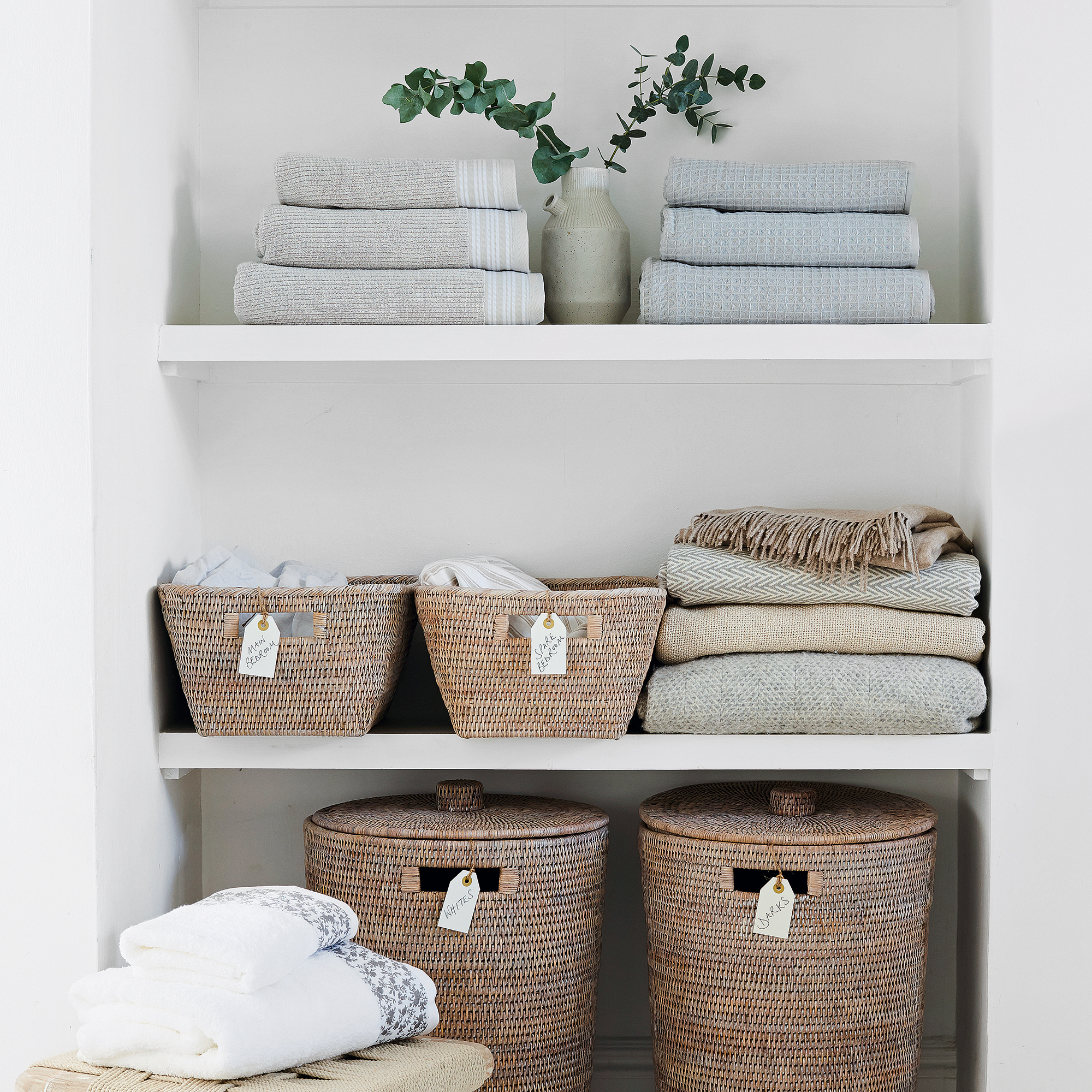How to store a duvet - professional organisers explain why you should never fold a duvet
Plus, the storage bags to avoid at all costs

- 1. Clean your duvet before storing it away
- 2. If you don’t wash your duvet, air it out
- 3. Make sure everything is totally dry
- 4. Cover your duvet up
- 4. Choose storage that will prevent mould
- 5. Roll – or fold carefully
- 6. Store in a dry place
- 7. Use a moth product
- 8. Refresh your duvet after storing it
- FAQs

Around the time the clocks go back, you might find your summer duvet isn’t quite cutting the mustard warmth-wise any longer. So it’s probably around now you want to change to a winter duvet. But what should you do with your summer duvet to keep it fresh during its winter hibernation?
We’re doing a deep dive into how to store your duvet, and chatting to duvet experts and home-organisation influencers who can shed light onto this. As a sleep-product writer myself, I’ve tested the best duvets on the market – and I know how expensive duvets can be.
So after forking out serious money for your duvet, when storing it away your, you want to keep it in tip-top condition. There are a few things you should be doing to ensure your duvet stays fresh, clean and in good nick over winter.
1. Clean your duvet before storing it away
‘Before storing your duvet, be sure that it is clean and dry before packing away for the season,’ says Kate Edmondson, Owner of Home Edited – a professional organisation service.
Remove your bed linen from the duvet before storing it away. Then wash the duvet according to its care instructions.
‘Wash bedding with lavender wash before storing,’ agrees Wendy Miranda, Customer Ambassador at Lakeland. ‘I recommend Lakeland Wool Wash Lavender Detergent.’

‘Feather duvets can be washed at 40 degrees to freshen up. Use around a quarter of the usual amount of detergent you’d use for other washes. The detergent is needed to clean but any more and it won’t rinse from the duvet. Then gently tumble on low.’
‘Always check the care label before cleaning. However, more often than not microfibre and down duvets can be washed at home on a gentle cycle utilising a mild detergent (non bio),’ says Home Edited’s Kate. ‘If your washing machine or tumble dryer is not large enough to hold your duvet, we would recommend professional cleaning, or even utilising a laundrette to tackle this task as they offer larger capacity washing machines and dryers.’
2. If you don’t wash your duvet, air it out
If you really don’t fancy the faff of washing your duvet, you should at least let it air out before packing it away.
‘Before putting your duvet into storage it's a good idea to give it a really good airing, outside if possible. A crisp, bright, dry day will help ensure no moisture is trapped in the duvet,’ says Gemma Bray, otherwise known as The Organised Mum.
This process will air out any bodily oils or smells before you pack it away for winter, and ensure it’s not musty come spring.

3. Make sure everything is totally dry
Moisture left in your duvet is going to be bad news. Your duvet will become mouldy and if it’s down or feather filled, it’ll cause the fillings to clump together. This will render your duvet unusable.
So whether you wash or just air out your duvet, make sure it’s absolutely dry before stowing it away.
4. Cover your duvet up
The last thing you want is your duvet getting dusty over winter. Dust mites are a key cause of allergies in the UK, and they feed on dust. An uncovered duvet would be like an all-you-can-eat buffet for them (grim!).
‘Keeping [your duvet] covered to minimise dust,’ is one of Kate from Home Edited top tips. We’ll get into what’s best to store your duvet in, but essentially don’t just shove it under your bed and hope for the best.

4. Choose storage that will prevent mould
You need to put your duvet in something that’s dry and unlikely to get damp or grow mould. ‘Utilise storage that is breathable to prevent mould and unpleasant smells,’ says Kate from Home Edited.
Breathable bags, such as cotton, are good for this. These allow air to circulate through your duvet. Plastic bags are less ideal as they prevent air flow, and can trap in moisture leading to dreaded mould. Bin bags are especially bad as they will also make your duvet smell unpleasant.
‘Breathable materials include cotton, linen, recycled polyester as well as polypropylene ( which can be budget friendly). Always be sure to check before purchasing if material is breathable,’ says Kate from Home Edited.
Kate at Home Edited recommends these bags from IKEA or these ones from Dunelm that are perfect for under the bed/in an ottoman.

5. Roll – or fold carefully
There’s a general consensus that rolling your duvet is better than folding to preserve the filling.
‘When it comes to folding I like to roll it, if you have the space,’ says Gemma from The Organised Mum.
‘If [you’re storing your duvet] in a box on a shelf I may use the ranger fold or roll,’ says Sophie Liard, aka The Folding Lady. ‘This is where you folding a portion of the duvet under, then fold in the sides so they slightly over lap, then starting from the top and working towards your first fold you can roll or fold the duvet, when you get to the end fold the first fold back on itself and it secures the duvet in.’

6. Store in a dry place
Choose where you store your duvet carefully. You need a cool, dry place in your home where it can comfortably fit. Slightly damp attics or a cupboard in the kitchen isn’t going to work here. And you definitely don’t want to stack anything on top of your duvet, as this will damage the fillings.
‘If you do have a bed with storage underneath, this is the perfect place to keep your duvet as it is a designated space and less likely to put things on top,’ says Gemma from The Organised Mum.
‘If storage space is limited and you’re unsure on where to store, once you have contained your duvet in the right storage bag consider utilising spaces under or behind beds, top or back of wardrobes, or designated cupboard or chest of drawers. There is no need to purchase any further storage,’ advises Kate from Home Edited.

7. Use a moth product
‘However you choose to store add a moth product to items being packed away just to be safe,’ says Wendy from Lakeland.
These moth-repellent sachets from Lakeland are perfect, and you get 20 sachets in a set so you can pop some in with your summer wardrobe if you’re stowing that away too. They should help keep moths away from your duvet whilst in storage.
8. Refresh your duvet after storing it
‘When unpacking duvets pop then in the tumbler with dryer balls to plump up, you can also pop the bedding in the tumble on low heat with a clean lightly damp fragranced cloth for a lovely fresh smell when you can’t get laundry out in the fresh air,’ says Wendy from Lakeland.
Just add a few drops of your favourite essential oils to a cloth, and chuck it in the drier with your duvet. And hey presto, your duvet is ready for another season.
FAQs
Is it ok to store a down duvet in a vacuum bag?
It’s tempting to use a vacuum bag to store duvets, as they’re such a space saver. However, you need to be careful as squeezing all the air out of your duvet can cause the fillings to get damaged.
‘When it comes to storing our duvets it is important we store them correctly,’ warns Kate from Home Edited. ‘As handy as a vacuum bag can be, I would advise against storing down duvets in them due to breakage of the quills of the feathers.’
But if you’re dead set on a vacuum bag, then there are some tips to help.
‘You can store down or feather duvets in a vacuum bag but you need to leave some air in there so that they’re not damaged. I’d suggest you stop before the bag is compact/compressed,’ says Carly Bullock, a buyer at Lakeland.
‘If you have to use a vacuum bag please ensure the duvet is bone dry before you put it in and ensure the vacuum seal is intact,’ says Gemma from The Organised Mum.
How to fold a duvet for storing?
‘I’d recommend lightly rolling down feather duvets so they don’t get squashed. Any other duvets should be ok to fold,’ says Carly from Lakeland.
‘When storing down or feather duvets, it is best to loosely roll up the duvet and place in a storage bag,’ agrees Kate from Home Edited. ‘Be sure to purchase storage that is the right size for the duvet. And once contained, label it correctly for easy identification; before you know it, the warmer weather will be here.’
If you store your summer or winter duvet correctly it should still be in tip top condition when you unpack it next year.
Get the Ideal Home Newsletter
Sign up to our newsletter for style and decor inspiration, house makeovers, project advice and more.

Zoe is a freelance journalist and content strategist. Her career has traversed kids' publishing, women's lifestyle magazines, luxury property and content marketing. She's worked for the BBC, STYLIST, Marie Claire, heat, Wallpaper*, InStyle, The Sunday Times Style, Ocado, Christie's and more. She now regularly writes about interiors and sleep for a range of media – what she doesn't know about mattresses isn't worth knowing.
-
 A top-to-bottom renovation has turned this Edwardian house into a lovely family home
A top-to-bottom renovation has turned this Edwardian house into a lovely family homeWith a few considered structural changes, this period house has been turned into a family home and has created a sanctuary for years to come
By Maxine Brady
-
 How to heat a conservatory
How to heat a conservatory7 practical options to consider for year-round comfort
By Amy Reeves
-
 Blueberry is the ‘it’ blue this spring - but these are the 3 colours you should never pair with it, according to experts
Blueberry is the ‘it’ blue this spring - but these are the 3 colours you should never pair with it, according to expertsAvoid overpowering your space by avoiding these three bold colours
By Kezia Reynolds